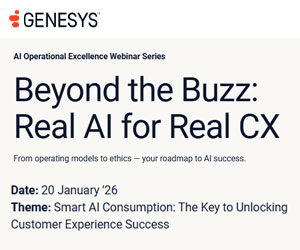WFM roles are evolving – fast. So what can we expect to see in 10 years’ time?
Our Editor – Megan Jones – spoke to experts working at the forefront of the resource planning world to find out what might be in store.
Here’s what they said…
“The Role Will Focus on a Hybrid Workforce of Humans AND Robots”

How we think of the “workforce” in workforce management” will change considerably as businesses adopt the mindset of managing a hybrid workforce of AI agents AND human agents.
So much so that the board will be talking about the hybrid workforce too, with conversations such as “We’re launching this new service to our customers. Are we going to need our AI workforce or human workforce to support it – or even both?” Cost per interaction is going to be a big driver in these decisions too.
Contributed by: Juanita Coley, CEO & Founder of Solid Rock Consulting
“We’ll Have a More Comprehensive Answer to ‘Why Was Today Different from Yesterday?’”

AI will continue to change the way we do things – for the better – particularly in understanding the influences on forecasting and volumes, bringing together ever-broader data sets and more factors than ever before for an in-depth look at “what was different today compared to yesterday?”
Just think, you could even have a scenario where the weather forecast is showing a storm is closing in, and you are able to tell which percentage of customers are likely to be affected and where – based on how a similar storm four years ago played out on your call volumes.
Quite simply, we’ll have a better understanding than ever before of customer behaviours and trends, so we can be more proactive in how we respond.
Contributed by: Karl Fletcher, Resource Planning and MI Manager at Novuna
“Resource Planners Will Be Seen as Business-Critical Roles”

The biggest shift will be in how planning is seen within businesses. The best companies will treat resource planning as a core part of their strategy, not just a support function.
This means planners need to keep learning, keep questioning, and keep pushing for better ways to work.
The last 25 years have shown that when resource planning teams take the lead, businesses run better. The next 25 will be about making sure that influence keeps growing. By 2035, resource planning roles will look very different – but they’ll be more important than ever.
Planners won’t just be building rotas or running forecasts. They’ll be working closely with AI tools that do the heavy lifting when it comes to data crunching.
The role will be all about making sense of the insights, not just producing the numbers. Think less spreadsheet work, more strategic thinking. They’ll guide decisions on everything from hybrid working patterns to customer experience design.
Contributed by: Phil Anderson, CEO of The Forum
“We’ll Still Need WFM Teams to Maintain Good Relations With Agents and the Wider Business”

Technology is going to continue to improve, but we’re still going to need people in resource planning roles to maintain good relations with agents and the wider business.
The human factor will be key. The department won’t just run itself!
Contributed by: Jamie Storer, Sr Manager, Workforce Optimization at Columbia Sportswear Company
“The Spotlight Will Be on How We Manage All Resources Responsibly”

There is another layer to consider with WFM as we introduce digital concierges/agents, as you’d be amazed at how much energy is consumed by one search with Generative AI!
With more and more companies being held accountable to sustainability principles, this will be at the forefront of how we use AI-Powered service tools in the future.
As we get ever-closer to 2035, WFM leaders will likely be balancing efficiency with strategic value across ALL resources, digital and human.
Contributed by: Nate Brown, Head of CX Advisory for Metric Sherpa and Co-Founder of CX Accelerator
“Carrying Out Manual Shift Changes Will Be a Thing of the Past”

With real-time automation tools taking huge leaps and bounds, the role of a real-time analyst will be changed forever; gone will be the days of endlessly staring at an RTA screen and manual shift changes in WFM systems.
In its place, confidence factors and thresholds will be set by the human real-time analysts and then will be delivered by AI real-time analysts, with people being accountable for decisions and implementation.
An RTA’s role will instead be more about bringing the human touch to a digital world. Perhaps the real-time role will even merge with a more people-focused role like a team leader, making sure that agents get the support they need to deliver the best service for customers.
Contributed by: Sarah Thompson, Senior Planning and Insight Lead at Skipton Building Society
Adoption rates for WFM systems have climbed significantly in recent years. To find out why, read our article: From Chaos to Control! Why Contact Centres Are Prioritizing WFM Solutions
“Tomorrow’s WFM Analysts Will Be Coding More”

The ability to write code is an important skill to have in workforce management and will be even more useful for a WFM analyst in the future.
Looking ahead, it will be easier to automate planning processes by creating code to perform WFM tasks. There will be more code snippets shared across community networks. And AI tools, while helpful now, will be even stronger at assisting in building the tailored apps you want to benefit your organization.
Specifically, coding in Python opens the door to an enormous range of advanced statistical and machine learning forecasting techniques, as well as simulation building blocks.
So, for anyone thinking about how they might future-proof themselves, my tip is to learn Python to enhance your forecasting, resource planning and performance improvement efforts.
Contributed by: Philip Stubbs, Partner at Atlantic Insight
“WFM Teams Will Evolve Into Bot Controllers”

WFM teams will be streamlined – with more roles being involved with automation, and control of that automation. This will include bot controllers, writing and updating scripts, checking outputs and reports.
Day-to-day tasks, optimizations and analysis will then be controlled and updated in real time by these bots. With more time on their hands, WFM teams will then likely be more involved in the general wellbeing of agents.
Contributed by: Jonathan O’Connor, Resource Planning Manager at Tructyre
“Organizations Like The Forum and SWPP Will Continue to Help Planners Sharpen Their Skills and Drive Results”

Planning is about storytelling, calculating, presenting, and refining. The past decade has been about giving planners better tools, not replacing them.
The job hasn’t changed – planners still manage the cycle, using whatever technology is available to sharpen their work.
As workforce demands grow in complexity, new tools will continue to emerge – some useful, some not. Planners will adapt, as they always have, leading organizations through an increasingly fast-paced world.
Even as we reach 2035, organizations like The Forum and The Society of Workforce Planning Professionals will continue to provide training and support, helping planners sharpen their skills and drive results. Because at the end of the day, planners are magicians, and they always will be.
Contributed by: Alec Bowman-Clarke, WFO Consultant at Darling Solutions Ltd
“WFM Teams Will Be Reduced Down to a Single Business Advisor Role”
I expect there’s going to be a reduction of headcount in WFM teams.
So rather than a team of 10 people sat there performing different roles – across forecasting, scheduling and real-time – it’s very likely to be condensed down to a single business advisor role, who has various tools and insights at their fingertips.
Contributed by: Juanita Coley, CEO & Founder of Solid Rock Consulting
“Soft Skills Will Count More Than Ever Before”
Soft skills will count more than ever. Listening, influencing, storytelling with data will be essential. The tech will be smart, but it’s the human judgement behind it that will make the real difference.
We’ll also see more planners embedded in cross-functional teams – working alongside product, marketing, HR and IT (not just operations).
Demand planning won’t be limited to contact centres, it’ll be about the whole customer journey, across every channel and every team.
Contributed by: Phil Anderson, CEO of The Forum
To get you started on the soft skills that are worth developing in your agents, read our article: 5 Soft Skills Every Agent Needs Before Taking Their First Call
The Future of WFM Is Human-Led, Tech-Enabled, and Ever-Evolving
By 2035, workforce management roles will look dramatically different.
Technology will take on more of the tactical workload, yet it will be the people who will bring the insight, judgement, and emotional intelligence needed to make it all work.
As we look ahead, the challenge isn’t just keeping up with new tools, it’s using them responsibly and creatively, ensuring WFM remains at the heart of great customer and employee experiences.
For more advice and information on contact centre workforce management, read these articles next:
- How to Succeed in a Global Planning Role
- Why Workforce Management Deserves a Seat at the Strategy Table
- 10 Ways Resource Planners Can Make Their Voices Heard
Author: Megan Jones
Reviewed by: Jo Robinson
Published On: 7th Jul 2025 - Last modified: 20th Aug 2025
Read more about - Workforce Planning, Alec Bowman-Clarke, Artificial Intelligence (AI), Forecasting, Jamie Storer, Jobs, Jonathan O’Connor, Juanita Coley, Karl Fletcher, Nate Brown, Phil Anderson, Philip Stubbs, Predictions, Sarah Thompson, Scheduling, The Forum, Top Story, Workforce Management (WFM), Workforce Planning





































